If that option does not exist, then you may not have installed SVN.
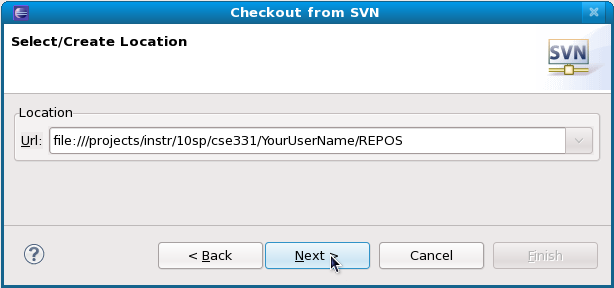
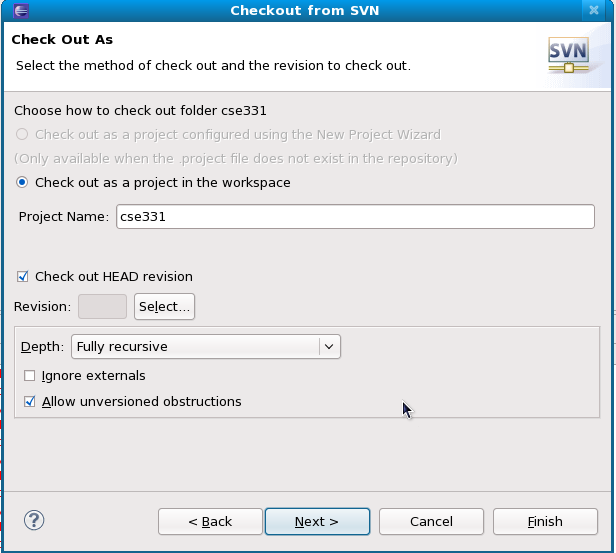
Contents:
SVN (Subversion) provides the following functionality:
SVN works as follows. There is a “repository” containing the master version of the files, including a history of all previous versions. Each user “checks out” a working copy of the files.
Each user can edit his or her copy of the files arbitrarily, without affecting other users or the master version.
Over many years of teaching courses like CSE 331, we have observed that on average about one student's computer will either die or be stolen during the quarter. Therefore, you should either work on computers in the instructional lab, or commit your work to the repository often. Committing often
You always edit your own personal copy of files that are under SVN control. Before you can make such edits, you must “check out” your own copies of the repository's master files. You only need to do this step once at the beginning of the term. If you are tempted to use this command at other times, you most likely want SVN's “update” command. In the case that you plan to work at both UW CSE and home, you will need to do these setup steps for both your IWS account and your home computer.
The following instructions assume you wish to check out a directory named cse331 from a repository that is located at /projects/instr/13au/cse331/YourCSENetID/REPOS/.
Throughout this document, you only need to do the work on the command line or in Eclipse, not both. If you plan to use Eclipse (as almost every 331 student does), you should follow the Eclipse instructions. However, you should be aware of the command-line versions, which you will find helpful because Eclipse lacks certain functionality and sometimes gets wedged. If you have trouble with Eclipse, then you should use the more reliable and versatile command-line tools. They work on all operating systems. Another option, which is also more reliable than Subclipse, is TortoiseSVN, which only works on Windows computers.
Execute the following commands at the Linux prompt to check out the project to ~/cse331:
From attu or any other departmental machine:
cd ~/ svn checkout file:///projects/instr/13au/cse331/$USER/REPOS/cse331
From your own computer:
cd ~/ svn checkout svn+ssh://attu.cs.washington.edu/projects/instr/13au/cse331/$USER/REPOS/cse331 cse331
NOTE (for those who are new to the command line): When you try to type passwords in the command line, you may be alarmed that you can't see any text entered. Don't Panic. In order to protect your password your typing simply isn't being shown. Just type your password as normal and press enter.
The following instructions will show you how to use Eclipse to check out SVN projects. Before doing so, please check to make sure that you have properly set up the Eclipse environment for CSE 331. We will assume that you will check out a project called cse331. When you check out cse331, Eclipse will automatically set up an Eclipse project named cse331 for you.


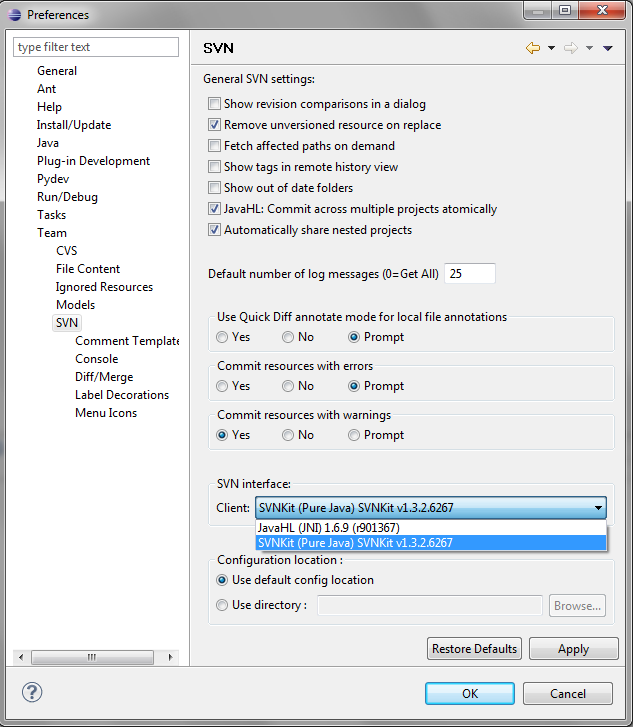
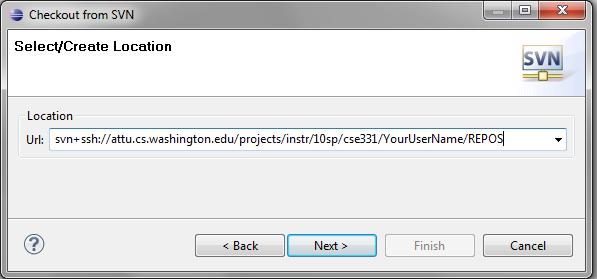
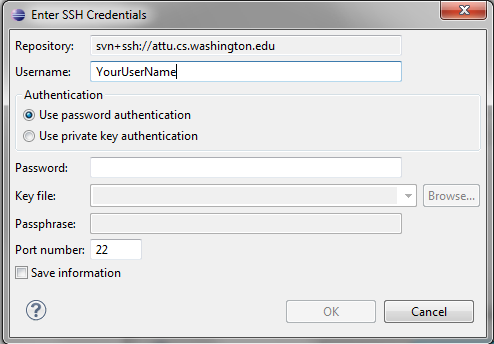
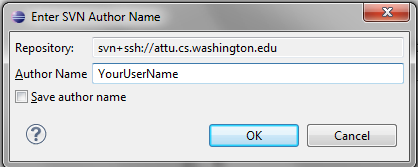
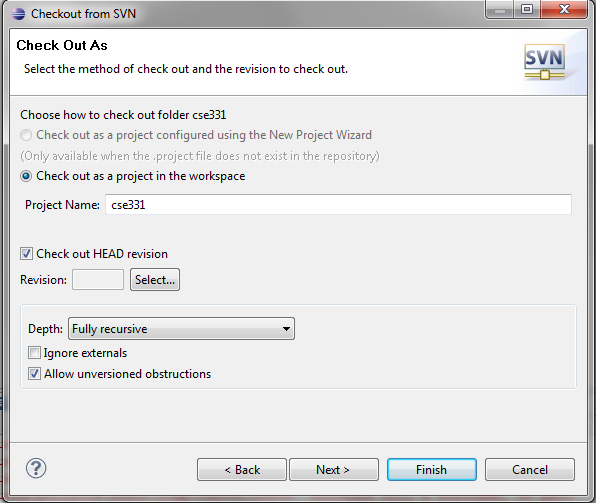
If you create a new file in a directory which is under SVN control, SVN will not automatically add it to the repository. This behavior is to avoid extraneous files from being added to SVN control. (You can tell when a directory is under SVN control when it contains a .svn sub-directory with files such as entries and dir-prop-base, none of which you should directly modify.)
You should not place compiler-generated or other auto-generated files under version control. This includes .class files and Javadoc files. You can tell SVN to ignore specific filenames or patterns (e.g., *.class) by running svn propedit svn:ignore . in the directory that contains the files to be ignored. Unfortunately, you have to re-run this in every directory that contains .class files. This simplifies SVN's update output in the presence of generated files (see this section).
To make SVN place a file under its control, first follow these instructions, then commit the file.
Right click on the file to bring up the context menu and select Team » Add to Version Control`
Note: if you create a file or folder in an Eclipse project but via the command line (or any mechanism outside Eclipse), then you will need to “refresh” the package explorer for Eclipse to recognize the change. To do this, right click on the project name in the package explorer and select the “refresh” item.
If you're are attempting to add a file to the directory ~/cse331/src/hwN/ directory, first you should cd to that directory:
cd ~/cse331/src/hwN
Now you can add a file (or directory) as follows:
svn add RandomHello.java
SVN's "update" command updates your local copy of files to reflect changes made to the repository by other people (or by you when working on a different computer system). The only changes made by people other than you will be made by the CSE 331 staff when we are adding new hws to your repositories. If you work at home and at UW CSE, you will need to use update to propagate your changes between the two locations.
SVN usually does a good job of merging changes made to multiple checkouts (say, by different people or by you on your home computer and you at UW CSE), even if those changes are to different parts of the same file. However, if both people change the same line of a file, then SVN cannot decide which version should take precedence. In this case, SVN will signal a conflict during SVN update, and you must resolve the conflict manually. This can be an unpleasant task.
To minimize the possibility of conflicting changes being made simultaneously, you should update frequently and commit frequently.
In the Package Explorer window, right-click on a file or directory, and select Team » Update. If the selected item is not a directory, just that file will be updated; otherwise, everything inside the directory will be updated.
To update your local copy, go to the root of your repository (e.g. ~/cse331) and run:
svn update
This will display a list of files that have been updated. You should pay attention to the character that shows up in front of each file, as it indicates what sort of change was made to the file:
| A | Indicates that this file has been added successfully. |
| D | Indicates that this file has been deleted successfully. |
| U | Indicates that this file has been updated successfully to match the latest copy in the repository. |
| G | Indicates that your working copy of the file is different from the repository's latest version, but that merging the repository's copy with yours is successful. |
| C | Indicates that there was a conflict when trying to merge your local copy of the file with the one in the repository. (See Resolving Conflicts for more information.) |
After making changes to, adding, or removing files, you must "commit" your changes to SVN. This step will cause SVN to record your changes to the repository, so that your changes are backed-up and available to other people working on the repository, or to you when working on a different computer system.
In general, you should "update" your files before committing them. (And, if the update results in any conflicts, you should resolve them before committing.) If you forget to update, SVN will abort and remind you to update first.
It is a good idea to commit your changes frequently. It backs up your work, thus enabling you to revert to an earlier version of your code if you find yourself going down a wrong path. Also, when you are working with others, it minimizes conflicts.
First, enter the directory in which the file(s) you wish to commit are located. For example:
cd ~/cse331/src/hwN
Then, you can commit a group of filename(s) to SVN by running:
svn commit -m "a descriptive log message" filename(s)
If you omit the message flag -m "a descriptive log message" from your commit command, SVN will throw you into an editor where you can enter a message.
If you omit the filename(s) from your commit command, then SVN will recursively commit everything in the current directory. Be careful not to inadvertently commit files that you don't want to commit.
Enter a descriptive commit comment, and click Finish. The lower panel shows you the list of files that you have modified and that will be committed to the SVN repository.
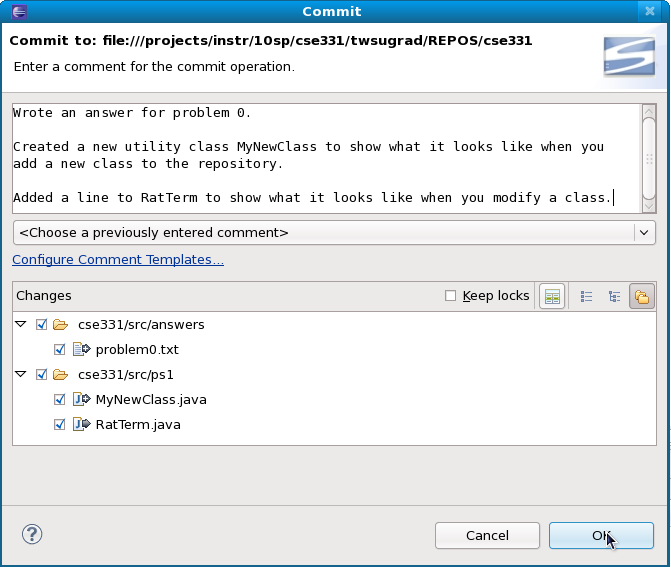
When multiple people (or the same person on multiple machines, such as the lab machines and your own computer) are working on the same file concurrently, SVN tries to merge the changes made by each person together as each person calls SVN update. Usually, SVN succeeds. However, sometimes SVN is unable to merge the files together when there are two different changes to the same line of a file. In this case, SVN will signal a conflict during the update; svn update will produce output such as Conflict discovered, and svn commit will produce output such as Commit failed (details follow): ... Aborting commit: 'myfile' remains in conflict.
SVN conflicts are rare — most students will never encounter one — but if you do get a SVN conflict, you need to resolve it. This is a very brief primer about resolving conflicts; you can read the SVN documentation to get the full story. Also, it's better to prevent a merge conflict than to have to resolve it later on.
You can resolve conflicts within Eclipse; see its documentation for instructions. However, we've had some reports of problems with Eclipse's SVN support. If you have trouble with it, then you can work from the command line. Again, see the SVN documentation for full details.
To see the status of all your files, run svn status. This will tell you, for each file and directory, whether it is currently in a conflicted state or not.
Subversion distinguishes two types of conflicts. A file conflict results from simultaneous overlapping edits to a file, and is the more common type. A tree conflict occurs when a file is moved or deleted in one checkout, and is edited or differently moved in the other checkout.
When SVN detects a file conflict, it changes the file to include both versions of any conflicting portions (yours and the one from the repository), in this format:
<<<<<<< filename YOUR VERSION ======= REPOSITORY'S VERSION >>>>>>> .r128 -- repository version's revision number
For each conflicting file, edit it to choose one of the versions (or to merge them by hand). Be sure to remove the <<<<<<<, =======, and >>>>>>> lines. (Searching for "<<<" until you've resolved all the conflicts is generally a good idea.)
Once you have made these edits, then you can tell SVN that you have resolved the conflicts in that file by typing a command like:
svn resolve --accept=working src/hw2/test/SpecificationTests.java
Resolving a tree conflict is similar, but instead of or in addition to editing the file, you must manually decide which of the versions you prefer and move it to the checkout you are working with. Then, you can run a svn resolve --accept=working myfile command, just as for a file conflict.
The text above showed how to fix a merge conflict if one occurs. It's better to prevent them in the first place. Conflicts are possible even when you are working by yourself.
The remainder of this section gives tips for preventing merge conflicts when working with teammates.
SVN is no replacement for management! Coordination of work is important, even if you're working separately. You should minimize working on the same file at the same time if possible. If you do work on the same file, work on different portions. Modularizing code into multiple files often makes parallelizing work more efficient. You should always pass major design decisions by your teammates before implementing them, particularly if they involve interfaces that will affect their code.
When and how often should you commit? If you commit too often without sufficient testing, you may introduce bugs into the repository that will affect your teammates' work. However, if you commit too rarely, your teammates will be using outdated code, which may cause wasted effort and merge conflicts later.
There is no hard and fast rule, but one good rule of thumb is to make sure everything at least compiles before you check in. If you check in non-compiling code, your teammates will be very annoyed when they update (which is good practice) and they cannot compile the code any longer.
Another good rule of thumb (though this one is far more malleable) is that you should minimize leaving something uncommitted when you quit for the day. A lot can happen while you're not coding, and it's generally better to get your changes in working order and commit it before you leave. Large amounts of uncommitted code being committed all at once will result in much more conflicts than small amounts of code being committed often. Since the previous rule (of never checking in non-working code) is more important, this can be hard to accomplish if you're making big changes. Thus, it's often good to tackle one feature at a time, so you can finish each piece quickly and keep the repository up-to-date.
Coordinating your efforts with your teammates is, of course, the true key to minimizing merging hassles. Again, SVN is no replacement for management!
There will often be files that you do not wish to check into SVN. These will include .class files and Javadoc files. However, SVN will, annoyingly, point out the existence of these files whenever you update. A solution is to tell SVN to ignore these files by setting the svn:ignore property:
svn prohw svn:ignore ON file(s)
Alternatively, you can modify the ignore policy for an entire directory with the command:
svn propedit svn:ignore dirname
This will open an editor where you can enter the names of the files and directories to be ignored. Each file name should go on a separate line. You can also use * to match any file. For example, to ignore all the class files in the directory, add *.class.
To ignore a file that is not under version control, right click on the file to bring up the context menu and select Team » Add to svn:ignore. This will bring up the dialog:
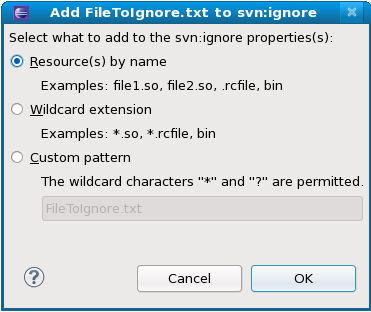
You can ignore just the selected file by choosing “Resource(s) by name” and clicking OK. Alternatively, you can specify a pattern used to ignore files in the directory containing the file you had originally selected.
You can edit the set of files being ignored in a directory by following these steps:
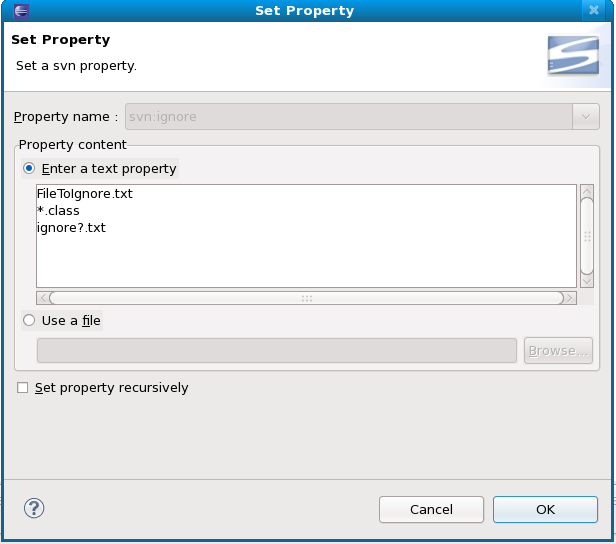
You can add a sub-directory with:
svn mkdir dirname
To delete a directory or file from the repository, use the svn delete command:
svn delete dirname
After adding or deleting a directory, you must perform a commit for the change to be reflected in the repository.
Eclipse conveniently marks files and directories that have changed since the last SVN update by adding an asterisk to the file's icon the Package Explorer. In addition, there are two features that allow you to track changes between your working copy and the repository's latest copy: Compare and Synchronize.
To compare a file with its latest version, right-click it in the Package Explorer and select Compare With » Latest from repository. If the files are different, a window will appear showing a side-by-side comparison of the two files.
To see a summary of differences between the local copy and the repository, right-click a file or directory in the Package Explorer and select Team » Synchronize with Repository. A window will appear that summarizes which files (if you selected a directory) have outgoing changes (changes you've made after updating), which have incoming changes (new revisions committed by others to SVN), and which have conflicts. Double-clicking one of these summarized items will bring up a Compare window for that file.
To view SVN commit logs and previous revisions to a file, right click it in the Package Explorer and select Team » Show History. You will see a History window in the bottom panel. Double-clicking a row will allow you to read the corresponding revision.
To see the change log, which is a list of the messages used when checking in changes:
svn log filename
To see differences between the working copy and the repository's latest copy:
svn diff filename
Omit filename to see differences for all files. Use the --revision N flag to compare with revision N, and use --revision N:M to compare versions N and M with each other.
You can retrieve an old version of a file under Subversion control with commands like the following:
svn update -r 140 MyFile.java
svn update -r {2013-03-14} MyFile.java
The first command used a revision number and the second used a date.
This command changes your working copy — that is, your local directory — but it does not change the repository. Do not attempt to edit the old version of the file in your working copy. Doing so will result in nasty merge conflicts and confusion.
You should save a copy of the file somewhere, then svn update your working copy to the current version of the file. Now, edit the current version in whatever way you like, possibly copying some or all of the differences from the old version that you saved. You can discard the old version when you are done; there is no need to check it in into SVN.
Some tips on avoiding common problems while using SVN: